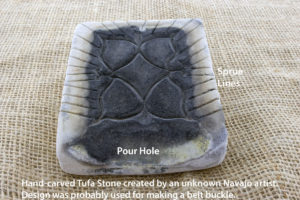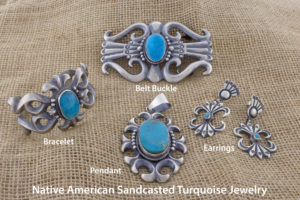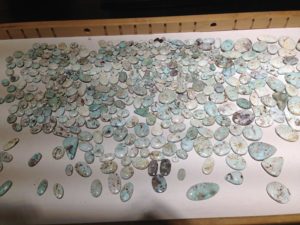Handmade sterling silver beads have a long history with the Native American community. We started researching the construction of these beads close to 50 years ago. It was important to us to be accurate in our descriptions and information, and the comments we gave out on all of our Native American items that we handled and sold. We had been misinformed about some products, and didn’t want to continue this practice, as many sellers thought it didn’t really matter.
We had met a gentleman who lived way out in the country specializing in handmade beads done by a brother /sister team, Dan and Helen Chee. They not only handmade all sizes of sterling silver beads but also created many products using these beads. Included were baby rattles of several styles, miniature pots of all sorts, thimbles, and a full assortment of other unique items. We watched them work, starting with stamping out the circular discs, stamping designs, punching the discs into half domes and punching a hole in the centers (this creates a ring of silver that is pushed out and creates a small ridge, noticeable on handmade beads). They then threaded the half discs onto a wire creating bead shapes, and then added a small piece of sterling silver solder inside each set. They then tightened the wire and rolled the soon to be beads on a flat surface while applying heat, which soldered the beads from the inside. They then treated the beads as normal sterling silver soldered items. This produced a true handmade sterling silver bead with a seam that possibly showed but did not make a “lip.”
Most sterling silver beads at that time were buffed to a high shine and were generally a heavier silver weight. Some artists today are buying pre-punched silver discs to make their handmade beads, but we don’t consider that as a problem. Bench beads are a different item. These are manufactured beads with a hole pre-drilled that are created with a seam or solder lip to make it easier to line them up to solder. These are many times hand soldered by a Native American artist, but not handmade. The lip would be noticeable on the finished sterling silver bead. Originally these were referred to as a sterling silver bench bead. The largest percentage of necklaces and squash blossoms made were strung on these sterling silver bench beads due to the comparatively high cost (even back then) of true handmade sterling silver beads. These beads were generally made of lighter gauge silver as well. Fast forward to today and we have seen a movement to grind the lip down on the bench beads (which many times leaves the top a little flat), then the beads are oxidized and buffed with steel wool to give the appearance of wear or patina. These are generally lighter weight sterling silver as well. The next bead is completely machine made out of a manufactured silver strip that is run through a machine that creates a 100% round (no seam) bead in about every size. Sometimes these are called ‘blow beads” and are generally lighter sterling silver weight – nothing handmade about them. These beads are hand strung and may be satin finished by a Native American artist. Some machine made beads might also be silver plated on a base metal. The price of these beads is indicated by the amount of actual handwork and weight of the sterling silver used in the manufacturing.






FREE US SHIPPING!